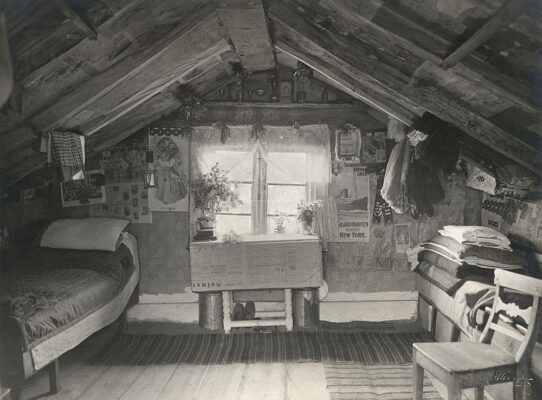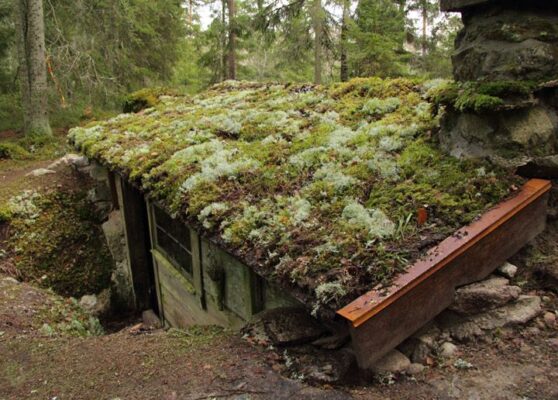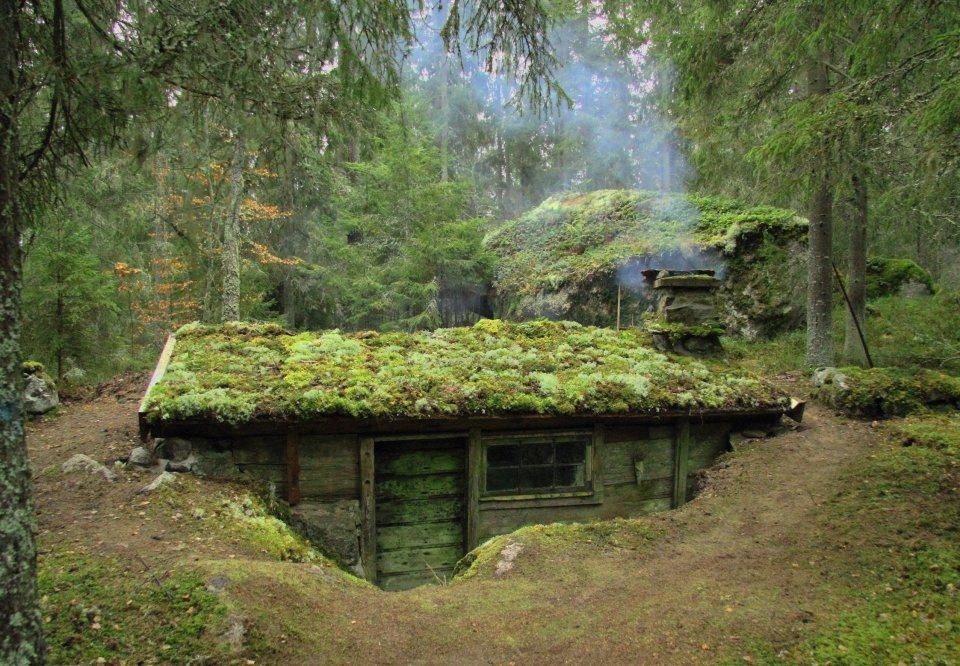In the heart of southern Småland, Sweden, a remarkable example of historical architecture can be found: the backstuga, or “hill cottage.” These small, earth-embedded cabins blend seamlessly with their surroundings, almost disappearing into the landscape. Although rare today, they once served as homes for some of Sweden’s poorest inhabitants in the 17th and 18th centuries. Follow archeology.dulichvn.net to discover many hidden mysteries that have yet to be discovered.

What is a Backstuga?
The term “backstuga” originates from Swedish, translating directly to “hill cottage.” This unique housing style is characterized by its partially buried design, with the cabin’s sod roof lying nearly flush with ground level, making it inconspicuous within the forest or hillside.
Design Features of a Backstuga
Earth-Integrated Construction
The traditional backstuga (a type of Swedish cottage) ingeniously incorporated the natural landscape into its architecture. These dwellings were typically built into the slope of a hill, with the hillside itself forming the rear wall and often one of the side walls of the home. This clever design minimized the need for additional building materials, as the earth acted as both a structural and insulating component. By leveraging the natural contours of the land, builders reduced construction costs and labor while creating a structure that harmonized seamlessly with its environment. The earthen walls also provided natural insulation, helping to regulate indoor temperatures throughout the changing seasons.
Single-Room Simplicity
The backstuga was a model of simplicity and resourcefulness, reflecting the modest lifestyles of its inhabitants. Typically, these homes consisted of a single multifunctional room that served as the heart of the household. This space fulfilled all essential needs—serving as the living area, kitchen, and sleeping quarters. The centralization of activities in one room not only conserved space but also maximized the efficiency of heating and lighting, as a single source of heat—often a fireplace or stove—could warm the entire dwelling. Despite their small size, these homes provided a functional and cozy living environment, tailored to the practical needs of rural life.
Sod Roofs
A defining feature of the backstuga was its sod-covered roof, a hallmark of sustainable and energy-efficient design. These roofs, constructed with a base layer of birch bark to provide waterproofing, were topped with a thick layer of soil and grass. The sod roof served multiple purposes: it offered excellent insulation, keeping the interior warm in the winter and cool in the summer, and it acted as a natural barrier against harsh weather conditions. Additionally, the vegetation growing on the roof helped the cabin blend into the surrounding landscape, making it less visually intrusive and more harmonious with nature. This design not only enhanced the home’s functionality but also demonstrated an early understanding of sustainable building practices.
The Historical Context
Humble Beginnings
The backstuga was more than just a type of dwelling; it was a symbol of survival and adaptation for Sweden’s poorest citizens. These modest homes were most often inhabited by those who had little to no financial means, such as landless laborers, elderly individuals, or families struggling to make ends meet. For many, the backstuga represented their only viable housing option, as it required minimal construction materials and often utilized unclaimed or marginal land. This type of dwelling allowed the impoverished to have a roof over their heads despite the economic and social challenges they faced. The simple yet functional nature of the backstuga made it an essential lifeline for those navigating the harsh realities of rural life in historical Sweden.
Resourceful Design
The backstuga reflected an ingenious response to the scarcity of resources, particularly in southern Sweden, where wood—a primary construction material—was both limited and expensive. With dense forests often reserved for landowners or timber exports, the general populace had to find alternative solutions. The design of the backstuga addressed this challenge by relying heavily on the natural features of the landscape. By building into hillsides, residents reduced the need for wooden walls and roofing supports, using the earth itself as a structural and insulating element. This minimized reliance on costly materials while maximizing the efficiency of what little was available. Even with limited resources, these homes provided a durable, weather-resistant, and functional living space, underscoring the practicality and ingenuity of their design.
Cultural Importance
The backstuga stands as a poignant reminder of the resilience and resourcefulness of Sweden’s rural poor. These homes are a testament to the enduring human spirit and the creative solutions devised to overcome adversity. They highlight the historical struggles of survival in a harsh environment where both natural and economic conditions were unforgiving. While often seen as symbols of poverty and hardship, backstugas also represent a deep connection to the land and a profound sense of community. They serve as a cultural marker of a time when resourcefulness and adaptability were vital for survival, offering modern observers insight into the lived experiences of Sweden’s past. Today, these homes are valued not only for their historical significance but also as an enduring example of sustainable living and a reminder of the resilience of those who inhabited them.

The Role of the Landscape in Backstuga Construction
The surrounding environment was a key factor in the construction of backstugas. These cabins were predominantly found in southern and southwestern Sweden, where the landscape was ideal for integrating homes into the hillsides.
Hillside Utilization
Natural Insulation
The design of the backstuga ingeniously leveraged the natural properties of the earth to create an insulated, energy-efficient living space. By embedding the rear and sometimes side walls of the structure into a hillside, these homes utilized the earth’s thermal mass to regulate indoor temperatures. During the harsh Swedish winters, the earth acted as a natural barrier against freezing winds and helped retain heat within the home, making it easier to stay warm with minimal fuel. In contrast, during the summer, the surrounding soil kept the interior cool by shielding it from the sun’s heat. This natural insulation eliminated the need for expensive and labor-intensive materials, offering a cost-effective and eco-friendly solution to temperature control that was both practical and sustainable.
Blending with Nature
The backstuga’s minimalistic construction philosophy extended beyond functionality, emphasizing a harmonious relationship with the surrounding environment. With their low profiles, earthen walls, and sod-covered roofs, these dwellings blended seamlessly into the natural landscape. The subdued design allowed the cabins to appear as though they were an organic part of the hillside, preserving the beauty and tranquility of the area. This unobtrusive integration reflected a deep respect for the land, a value that was essential to the rural communities that depended on nature for their livelihood. Rather than imposing on the environment, these homes coexisted with it, creating a unique aesthetic that was both practical and aligned with the principles of sustainability.
Efficient Use of Resources
In a time when wood was a scarce and expensive commodity in southern Sweden, the backstuga design offered a resourceful alternative that minimized the reliance on timber. The earth provided structural support for walls, while the sod roof further reduced the need for wooden beams and shingles. Builders could create a functional and durable home using only a fraction of the wood required for traditional houses. Additionally, the reliance on locally available materials such as soil, grass, and rocks kept costs low and construction feasible for the poorest members of society. This efficient use of resources exemplified the ingenuity and adaptability of those who built and lived in backstugas, turning limited means into sustainable and enduring homes.
Distribution Across Sweden
Southern and Southwestern Sweden
The backstuga was a product of necessity and geography, most commonly found in the hilly regions of southern and southwestern Sweden. These areas, characterized by their undulating landscapes, provided the ideal conditions for this type of earth-integrated construction. The naturally sloping terrain allowed builders to dig into the hillside, using the earth as a structural and insulating component. This approach was particularly advantageous in regions where affordable building materials, especially wood, were scarce. The combination of steep slopes and limited resources made the backstuga not only a practical solution but also a reflection of the ingenuity required to thrive in such challenging environments. Its prevalence in these areas highlights how regional geography shaped the architectural practices of rural communities in historical Sweden.
Forest-Dwelling Communities
Many backstugas were nestled within or near forested areas, where the dense canopy of trees provided additional benefits. The surrounding forests acted as a natural windbreak, shielding the homes from harsh weather conditions such as strong winds and heavy snowfall. The seclusion offered by the woods also afforded privacy and a sense of security to the inhabitants, who were often among the poorest in society. These forested settings not only enhanced the practicality of the backstuga but also added to its harmony with nature. The close proximity to woodland resources, such as fallen branches for firewood or small quantities of timber for construction, further supported the minimalist and resourceful lifestyle of backstuga dwellers. These homes exemplified a lifestyle deeply intertwined with the rhythms of the natural world.
Decline in Modern Times
With the advent of improved construction techniques, economic development, and rising living standards, the backstuga gradually became obsolete. The increased availability of affordable building materials and modern housing options allowed rural populations to move away from these humble dwellings. By the late 19th and early 20th centuries, many backstugas were abandoned or repurposed, and their distinctive design became a rarity in Sweden’s evolving architectural landscape. Today, surviving examples of backstugas are often preserved as cultural and historical landmarks, offering a glimpse into the lives of past generations. While they are no longer a common sight, their legacy endures as a testament to the resilience, adaptability, and ingenuity of those who built and lived in them.

Why Are Backstugas Important Today?
Though few remain, backstugas are a significant part of Sweden’s cultural and architectural history.
Architectural Significance
Sustainable Design
The backstuga stands as an early example of sustainable building practices, utilizing the natural environment to create homes that were both resource-efficient and environmentally harmonious. These dwellings were designed with careful consideration of the materials available in their surroundings. Builders used the natural slopes of hillsides to form walls, dramatically reducing the need for additional materials. The earth itself acted as both a structural support and an insulator, keeping the interior warm during the cold winters and cool in the summer without relying on costly or energy-consuming heating and cooling systems. Additionally, the sod roofs provided an insulating layer that further enhanced the home’s energy efficiency. By minimizing the use of wood and maximizing the potential of locally sourced, natural materials, the backstuga exemplified a sustainable approach to construction long before the modern environmental movement emerged.
Cultural Heritage
The backstuga holds a significant place in Sweden’s cultural heritage, serving as a tangible connection to the country’s rural past. These simple homes are not just physical structures but represent the resourcefulness and resilience of the people who built them. The backstuga was often the only option for the poorest Swedes, highlighting the challenges they faced in an era of limited resources. These homes were integral to the daily lives of rural families, offering shelter in an unforgiving landscape where access to materials and infrastructure was scarce. As a cultural artifact, the backstuga offers valuable insight into the history, social structures, and survival strategies of Sweden’s rural communities. Today, these homes are celebrated for their ingenuity, representing a way of life that was deeply connected to the land, and serve as a reminder of the hard work and creativity of past generations.
Modern Inspiration
Though backstugas have largely disappeared from the landscape, their design principles continue to influence modern architecture, particularly in the realm of eco-friendly, earth-integrated homes. Contemporary architects, drawn to the sustainable methods employed in these traditional structures, have found inspiration in the way the backstuga seamlessly blended with its natural surroundings and utilized the earth to create energy-efficient, self-sustaining homes. Today, earth homes and green architecture often draw upon the lessons learned from such designs, favoring natural insulation, minimal use of manufactured materials, and a harmonious relationship with the environment. The continued relevance of the backstuga design in today’s eco-conscious building practices speaks to the timeless nature of these early innovations, proving that sustainable architecture can transcend time and technological advances. By returning to the fundamentals of natural building, modern eco-homes continue to embrace the same principles that made the backstuga a practical, energy-efficient, and environmentally responsible dwelling in its time.
Preservation Efforts
Restoration Projects
In recent years, several backstugas have been carefully restored as historical landmarks, ensuring that their legacy is preserved for future generations. These restoration projects involve painstaking efforts to return these humble cabins to their original state, using traditional materials and construction methods whenever possible. The aim is not only to preserve the structures but also to educate the public about their historical significance and cultural value. By preserving backstugas in their original forms, these projects offer a tangible connection to the past, allowing visitors to step back in time and experience the simple yet ingenious ways people once lived. Restored backstugas serve as living museums, offering a glimpse into Sweden’s rural history, the daily lives of its people, and their resourceful methods of survival in an era of limited resources. These efforts also contribute to the broader movement of preserving Sweden’s architectural heritage, ensuring that the knowledge and appreciation of these homes are passed down to future generations.
Tourist Attractions
As Sweden’s cultural heritage becomes more valued by both locals and international visitors, backstugas have increasingly become tourist attractions, drawing people interested in exploring the country’s rich history. These cabins, once symbols of poverty and modest living, have been transformed into points of interest for those curious about traditional Swedish architecture and rural life. Tourists visit restored backstugas to experience firsthand the environment in which past generations lived, learning about the simplicity and resilience that characterized rural life. In addition to their historical value, these cabins offer a unique and intimate setting for travelers to explore Sweden’s countryside, often located in scenic areas surrounded by forests and hills. For many, visiting a backstuga is not just about seeing a building but also about immersing oneself in a piece of Sweden’s cultural identity, offering an authentic, educational, and enriching experience that connects the past with the present.
Architectural Studies
The backstuga has also become a subject of scholarly interest, especially among architects, historians, and environmental researchers. These homes are studied as part of a broader effort to understand historical construction techniques and sustainable living practices. Scholars examine the backstuga‘s innovative use of earth as a structural and insulating material, recognizing it as an early example of passive building design. Researchers look at how these homes, despite their modest size and limited resources, were able to maintain comfortable living conditions throughout the year. The backstuga provides valuable insights into the resourcefulness of rural communities in Sweden, showing how people were able to make the most of their environment without relying heavily on imported or expensive materials. Architects today often refer to the backstuga when exploring how traditional construction techniques can inform modern sustainable building practices, especially in an era increasingly concerned with environmental conservation. These studies contribute to a growing body of knowledge that links past and present, demonstrating how centuries-old techniques can continue to influence and inspire sustainable architectural solutions.
See more: Janjira Fort: The Undefeated Stronghold of Indian Maritime History
Conclusion
The backstuga is more than just a historical housing style; it is a symbol of resilience, ingenuity, and harmony with nature. While these humble cabins are rare today, their legacy endures as a fascinating chapter in Sweden’s architectural history. Whether as inspiration for modern sustainable housing or as preserved relics of the past, backstugas continue to captivate those who uncover their hidden charm.


CÁC TIN KHÁC
Mary Walton: The Forgotten Inventor Who Helped Clean Up America’s Cities
Tomb of Queen Nefertari in the Valley of the Queens, Egypt
Discover the Hypostyle Hall of the Temple of Hathor at Dendera
Venus de Losange: Unveiling the Mystery of a 20,000-Year-Old Paleolithic Icon